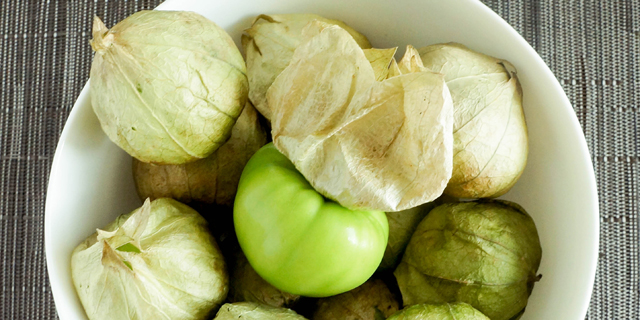Not to be confused with green tomatoes, tomatillos are small, tomato-like fruits that are popular in Latin cooking due to their bright color and tart flavor. Enjoyed by the Aztecs for their citrus, tangy flavor, tomatillos are a fruit that have been sought after by everyone from the Spanish conquistadors to the abuelita making homemade enchiladas. Delicious and bursting with nutrition, tomatillos are rich in potassium, Vitamin C and Vitamin A. Throw in a bit of calcium, folic acid, and Vitamin E, along with minerals such as iron and magnesium, and at just 11 calories per serving, tomatillos prove themselves to be a great addition to the latin diet.
How do I pick the best tomatillos?
Choose your tomatillos as you would your tomatoes. The fruit should be firm and yield to gentle pressure. Pay close attention to the husks. They should appear fresh, bright, and hydrated. The husk opens when the tomatillo is ripe, allowing you to take a peek at the fruit within. Steer clear from tomatillos that have soft spots or whose husks are brown and dried up, as this indicates the fruit is beyond ripe. Look for firm, bright green fruit if using the tomatillo in a traditional recipe such as a salsa verde. On the other hand, yellow tomatillos are a bit sweeter and work best as a jam. No matter where your tastebuds take you, the best recipes start with the freshest ingredients. Choose wisely.
What can I make with tomatillos?
Tomatillos are traditionally used in salsas, but the possibilities are endless because tomatillos can be both tangy and lemony or sweet and citrusy. Use raw tomatillos as a topping on your sandwich, salad, or taco. Simmered tomatillos make a great sauce to use with mild flavored meats like chicken and pork, while stir fried tomatillos with garlic and shallots makes a great side dish. Grill, broil, or bake to your hearts desire, these little green beauties can take the heat!
Preparation involves removing the husk and washing the tomatillos thoroughly. The tomatillo fruit may have a sticky residue on it from the husks. Just wash it off and slice, chop, dice, or mince your way to a delicious tomatillo dish.
And storage? If using in a few days store in open air on the counter in a shaded, cool area. If you won’t get to them within a few days time, store tomatillos with husks intact in the refrigerator where they will stay fresh for up to two weeks. To use up your left over tomatillos simply puree until a thick sauce forms. Freeze sauce in an ice cube tray and transfer cubes to a ziplock bag. This way you can add that distinctive, bright tomatillo flavor to your dishes or salsas all year round!
Recipes to try include: Sweet and Sour Eggplant with Tomatillos, Butternut Squash and Tomatillo Soup, and Salsa de Tomatillo.






![Making Mealtime Matter with La Familia: Easy Sofrito [Video]](https://thelatinkitchen.com/wp-content/uploads/2015/10/sofrito-shutterstock__0-500x383.jpg)
![Easy Latin Smoothies: Goji Berry Smoothie [Video]](https://thelatinkitchen.com/wp-content/uploads/2015/12/goji_berry-shutterstock_-500x383.jpg)
















![Fun and Fast Recipes: Fiesta Cabbage Salad [Video]](https://thelatinkitchen.com/wp-content/uploads/2015/11/fiesta_cabbage_slaw-shutterstock_-500x383.jpg)





